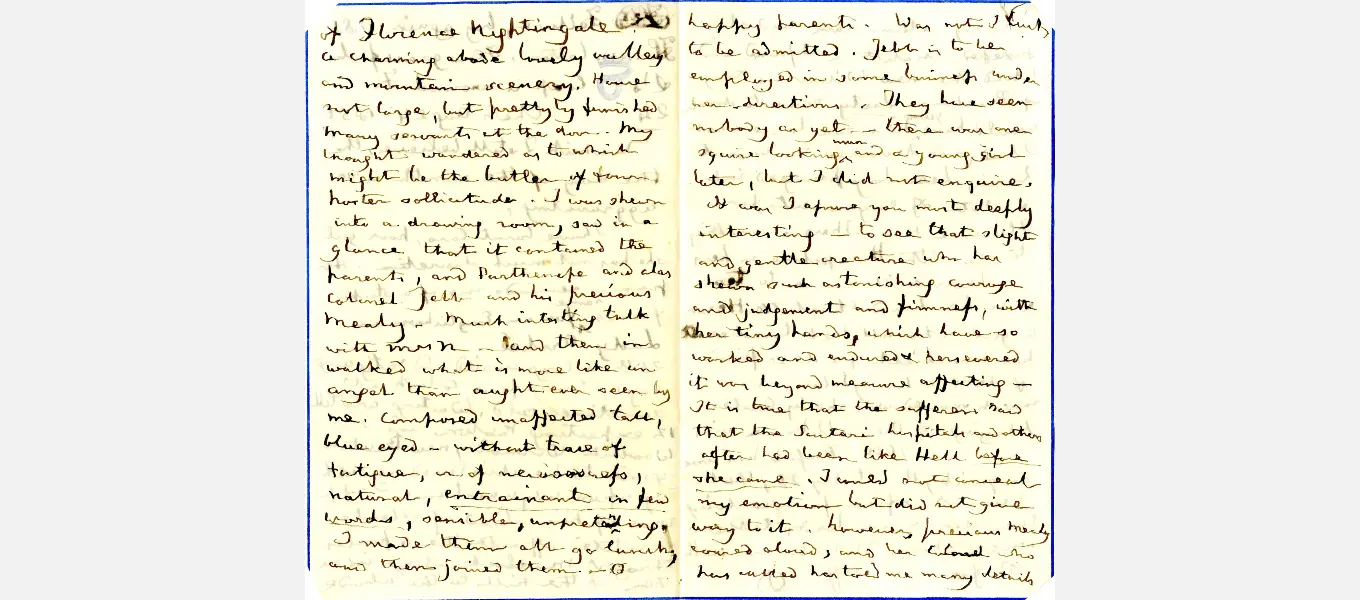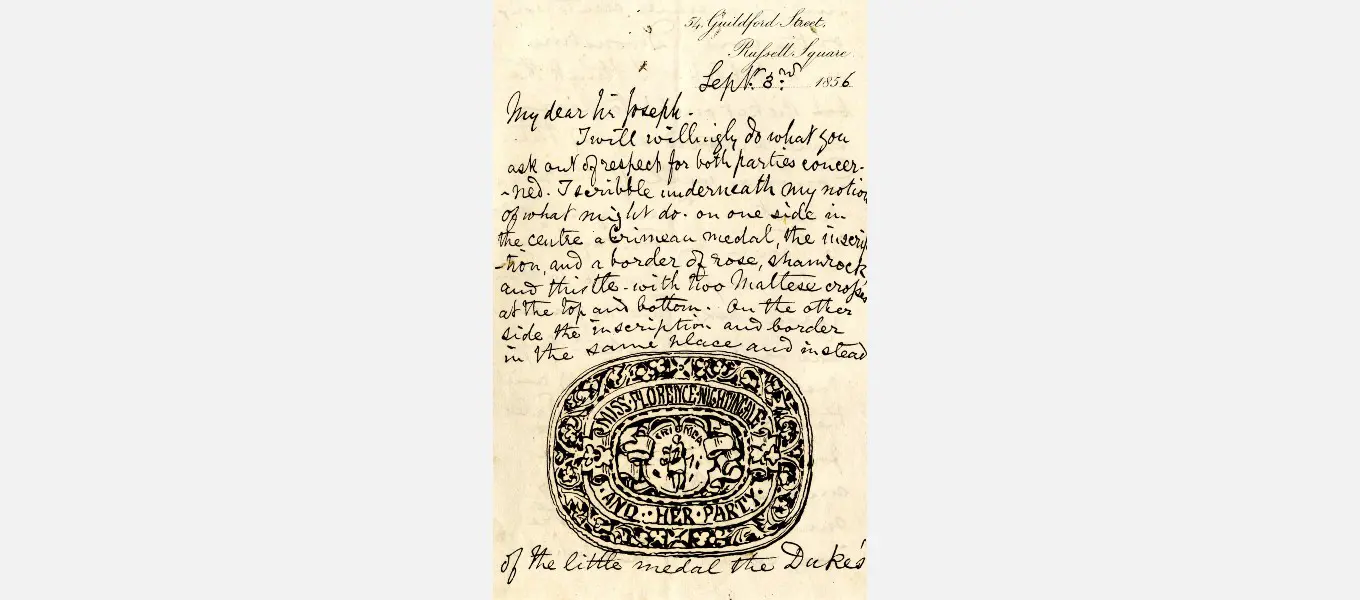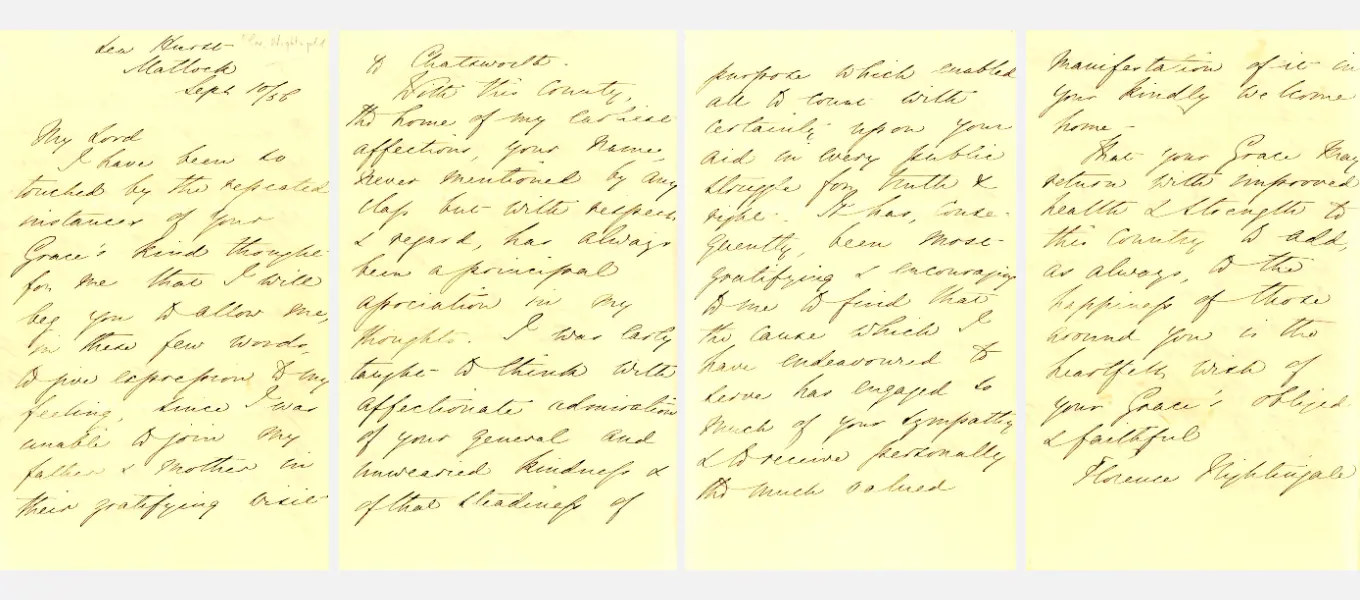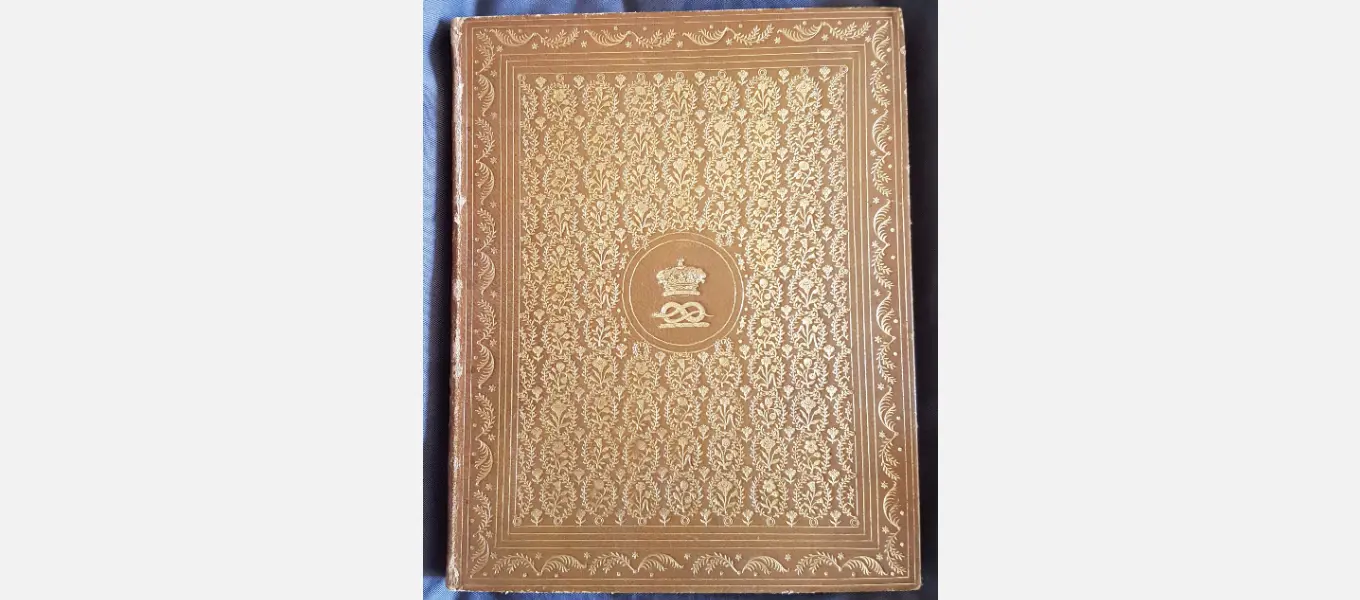Florence Nightingale (1820-1910) was a social reformer, statistician, and most importantly the pioneer of modern nursing. Her anniversary (12 May) has long been celebrated as International Nurses Day.
Florence Nightingale lived for part of each year in Derbyshire; her parents owned a house called Lea Hurst near Matlock, which they generally visited for a few months in the summer. Given the fame that Florence Nightingale – a Derbyshire resident – achieved during her lifetime, it is unsurprising that she should at some point encounter the 6th Duke of Devonshire (1790-1858).
The Duke had clearly been keeping up with Nightingale’s activities through the newspapers after the outbreak of the Crimean War. She arrived in Turkey with her team of 38 nurses in early November 1854, swiftly applying her formidable energy to the task of transforming the appalling conditions in which the sick and injured soldiers were being accommodated and treated. She worked to improve medical and sanitary arrangements, basic standards of hygiene, and insisted on order, discipline and uniforms for her nurses.
The Duke wrote to Nightingale’s parents to express his admiration for her work, and received a response on 14 December from her mother Frances. By that time Florence was dealing with 4 miles of hospital beds and over 3,000 patients, seeing four or five soldiers die every day. Her mother wrote ‘every day we receive testimonies of her usefulness which are very precious to us…General Bentinck writes that she has been known to spend 8 hours upon her knees dressing the wounds & giving consolation to the poor sufferers & that they bless her as she passes up & down the wards’. Reports like this, and accounts of her nightly vigils on the wards, turned her into a legend during her own lifetime.
In May 1855, while on a visit to inspect hospitals in the Crimea, Nightingale became seriously ill with ‘Crimean fever’, which affected her health for the rest of her life. The Duke enquired after her, and issued an invitation to her parents to join him for dinner at Chatsworth in August of that year. Her mother wrote to accept the invitation, and to pass on the news that Florence had recovered enough to be able to attend to her duties in the hospital at Scutari for five hours each day.
The Duke’s interest in Nightingale endured, and he was one of the first subscribers to the Nightingale Fund, established in late 1855. Ultimately it funded the Nightingale School of Nursing at St Thomas’s Hospital in London, opened in 1860.
Nightingale stayed on in Turkey beyond the end of the war until the hospitals were ready to close. She returned to Derbyshire in August 1856, by which time she was hailed as a national heroine. Hearing of her return, the Duke went to pay homage to Nightingale in person, and wrote a slightly star-struck account of his visit in a letter to his sister Harriet, Countess Granville, dated 24 August 1856. He described how, while conversing with her other family members, ‘in walked what is more like an angel than aught ever seen by me. Composed, unaffected, tall, blue eyed, without trace of fatigue, or of nervousness, natural…sensible, unpretending’. He marvelled over ‘that slight and gentle creature who has shewn such astonishing courage and judgement and firmness, with her tiny hands, which have so worked and endured and persevered…I could not conceal my emotion but did not give way to it’. Nightingale would perhaps have been grateful for that as she was rather more down to earth than many accounts of the time suggested.

The Duke issued a return invitation to her and her family to dine at Chatsworth. He was in great anticipation of the visit, but subsequently reported sadly to his sister ‘the angelic one had given me hopes that she was coming here today and she instead sent all the rest of the family’. It turned out that her failure to attend was due to an unexpected visit from her great friends Mr and Mrs Bracebridge (who had been instrumental in launching her career), which mollified the Duke, who reported to his sister that he had sent Nightingale ‘a sort of ticket’.
A letter survives elsewhere in Chatsworth’s archives which sheds some light on this: sent to the Duke’s head gardener and agent Sir Joseph Paxton by Matthew Digby Wyatt (a noted architect and art historian), it contains his elaborate design for the ‘ticket’, which was to be made of ivory. Tickets like this appear to have been fairly standard as a means of granting privileged access to favoured individuals. An ivory ticket to the Horse Guards Parade that was issued to Nightingale by the Queen is preserved in the Florence Nightingale Museum. As far as we know, the ticket issued by the Duke does not survive, but it would presumably have given Nightingale privileged access to Chatsworth (and potentially some of the Duke’s other estates).

Following Florence’s failure to visit Chatsworth with the rest of her family, the Duke received a very gracious letter from her, in which she wrote ‘With this county, the home of my earliest affections, your name, never mentioned by any class but with respect & regard, has always been a principal association in my thoughts. I was early taught to think with affectionate admiration of your general and unwearied kindness & of that steadiness of purpose which enabled all to count with certainty upon your aid in every public struggle for truth & right. It has, consequently, been most gratifying & encouraging to me to find that the cause which I have endeavoured to serve has engaged so much of your sympathy & to receive personally the much valued manifestation of it in your kindly welcome home.’

The Duke was so honoured to receive this letter that he didn’t keep it in his general correspondence files. Rather he mounted it in his autograph book, reflecting the esteem in which he held Nightingale, the value he placed on the single letter he received from her, and her status as a heroine of Victorian Britain.







